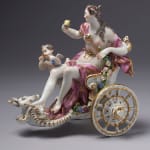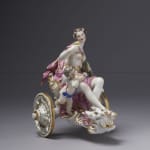

A rare Meissen Allegorical Figural Group of Venus and Cupid Riding in a Chariot, Circa 1745
Length: 7½ ins. (19 cms.)
A rare Meissen Allegorical Figural Group of Venus and Cupid Riding in a Chariot, representing the Triumph of Love, modelled by J.J.Kaendler, Venus sits within a gilded shell seated chariot, wearing a bejewelled gold sash, belt and stomacher, she holds an apple in one hand, her gazing head with long flowing hair adorned with pearls and roses. The winged Cupid stands at her right side, two Venus Love Birds at her feet and her Chariot is raised up on two highly decorative pierced porcelain wheels, with gilded highlights.
Venus goddess of Love, who was born of the shell, reclines in this baroque marine form. Her place in divine mythology and legend as pagan goddess of love is epitomised by her flowing hair, plunging décolletage and attributes of pearls and roses and other flowers symbolic of love. The apple reminds us of the fabled beauty contest at which she was judged the winner by Paris and her prize was the Golden Apple. Her billing Doves appear at her feet whilst her acolyte, the winged Cupid, endorses her place in myth and legend as the Triumph of Love.
See, Otto Walcha, Meissen Porcelain, colour pl. 96, for closely related modelling of the figures of Venus that appear as part of the elaborate finial constructions for some of the covers of the largest tureens, from the Swan Service modelled for Count Henrich von Bruhl by J.J.Kaendler circa 1737-41, where she is modelled in the same reclining pose together with Cupid. This ingenious model by J.J.Kaendler, alluding to the commemoration of the procession of the Triumph of Love, originally would have been placed with two rearing Hippocampi, appearing to pull the allegorical model depicting the Chariot of Love in its mythical progression.
The pose of Venus, gazing at her ‘golden apple’ recalls the painting by Rubens ‘Venus before the mirror’ in the collection of HSH the Prince of Lichtenstein, at Vaduz Castle. This allegorical theme alluding to love was brought to its zenith in the paintings of Francois Boucher and Jean-Honore Fragonard under the patronage of Madame de Pompadour, mistress of Louis XV.
Join our mailing list
* denotes required fields
We will process the personal data you have supplied in accordance with our privacy policy (available on request). You can unsubscribe or change your preferences at any time by clicking the link in our emails.

